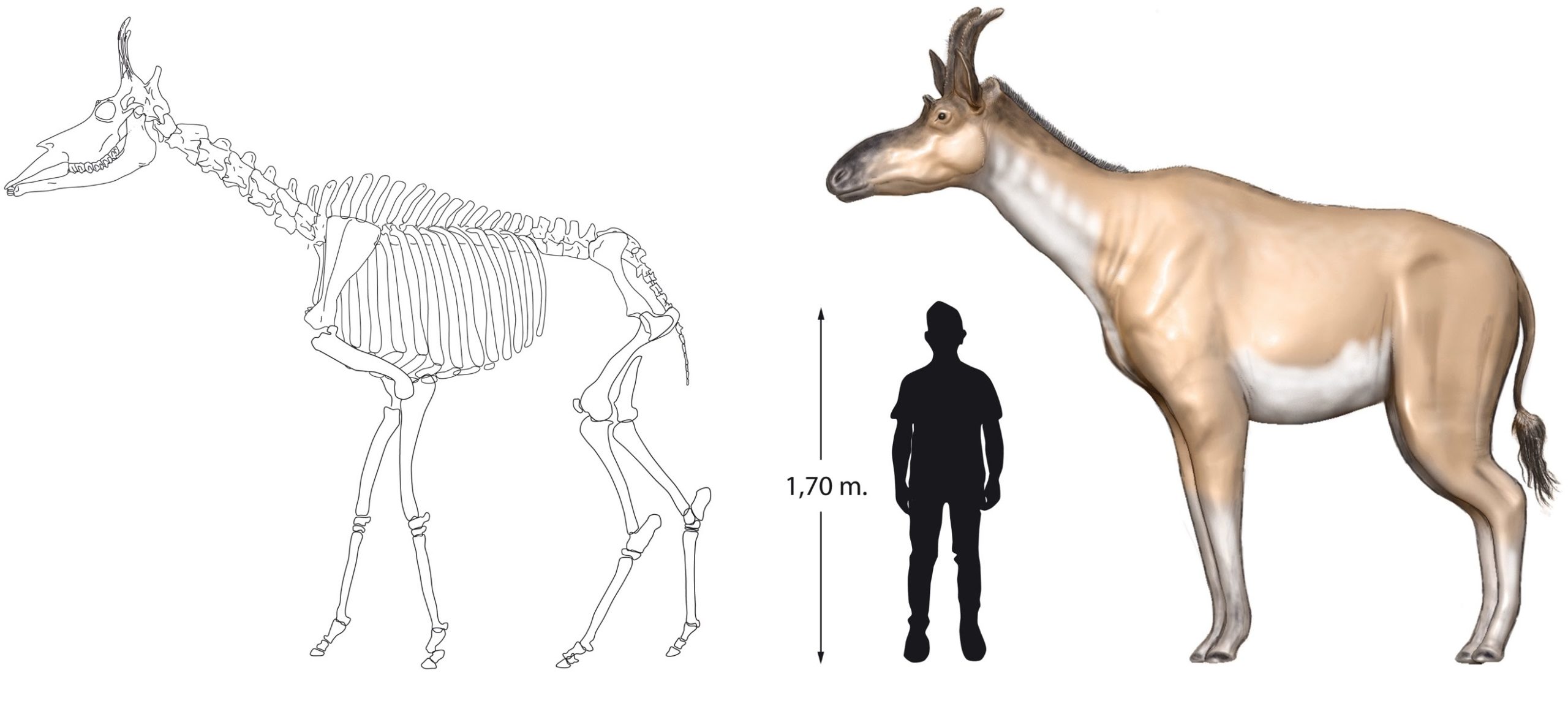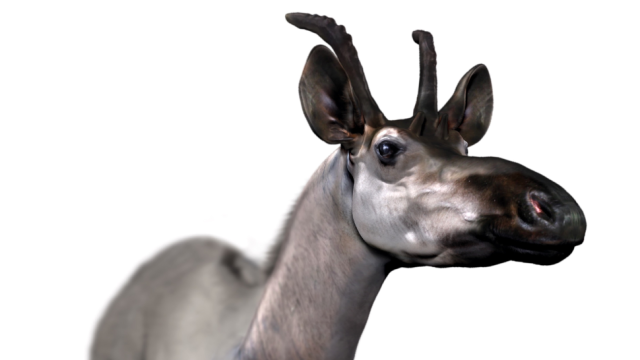Giraffes are hard to miss. Scraping the sky at roughly 5.5m up, they are the tallest animals on Earth. Humans have taken notice, becoming infatuated with giraffes from the first moments of the animals’ lives, and revering their iconic, alien gangliness across the globe. But despite all this attention, our species doesn’t have a particularly good grasp of the evolutionary history of giraffes and their relatives. But now, thanks to a newly-discovered fossil of a new species of extinct, ancestral giraffe, the giraffe family tree just grew a few more limbs and came into tighter focus.
Decennatherium rex. (Image: Ríos et al (2017))
The giraffe family (Giraffidae) is an exclusive club these days. Between a maximum of four species of giraffe and the secretive okapi (and its awesome zebra pants!), this denuded branch on the mammalian side of the Tree of Life is what remains of a formerly diverse and widespread bloodline. For millions of years, giraffes and their relatives (giraffids) were found all over the Old World – and many of them were flat-out strange. The familiar, high-rise models didn’t evolve until recently, and much of giraffid prehistory is marked by expansive evolutionary experimentation.
For instance, Bramatherium was a thick-set Asian giraffe with four spiny skull projections that formed an erect forehead shield, making it look like some kind of fuzzy dragon. Injanatherium was an antelope-like giraffe from the Middle East with a built-in visor of bone that jutted out over its eyes. There were also the giant, vaguely elk-like sivatheres – the most massive giraffids ever – with heavy, antler-shaped ossicones (skin and hair-covered skull protuberances found in giraffids).
Fossil records of all these bizarre species are generally spotty. With a paucity of complete skulls, for example, it’s been difficult to hash out the evolutionary relationships between giraffids. The new species – described in a paper published today in the journal PLOS ONE – is providing a key piece of this puzzle.
The ancient giraffe, regally named Decennatherium rex (pronounced “de-sen-a-theer-ee-um recks”), was unearthed in the Cerro de los Batallones fossil site just outside of Madrid. The team of palaeontologists responsible for D. rex’s discovery and identification – based at Spain’s National Museum of Natural History and the Catalan Institute of Paleontology – estimate that it lived about nine million years ago. The skeleton was uniquely, remarkably complete, and provided a great picture of what D. rex must have been like in life.
The giraffid had two pairs of ossicone “horns”; one short pair in front, above the eyes, and a second, long, curved, ridged pair that swept up and backwards. D. rex was tall enough to scratch its head on a basketball rim, and probably weighed in excess of a tonne. With such a strapping frame, the beast would have looked less like a graceful sentinel of the Serengeti, and more like if that Toys ‘R’ Us mascot took up a serious powerlifting hobby.

Decennatherium rex size comparison with a human. Credit: Ríos et al (2017)
By comparing D. rex‘s remains with those of extinct and living giraffid species, the researchers were able to determine likely evolutionary relationships between giraffid groups. It appears as though the new Decennatherium species is the earliest known offshoot of a lineage containing the gigantic, “antlered” sivatheres, and another similar group, the samotheres – a different fork of the family tree from where giraffes and okapi reside. The four-horned layout that helps define this sivathere-samothere branch – two small in front, two big in back – may have gotten its start with D. rex.
This discovery and classification for Decennatherium reveals that the sivathere-samothere line is millions of years older than previously thought, and had existed as far north as Europe. Sivatheres and samotheres were ridiculously successful giraffids, ranging across much of Africa and Eurasia for what appears to be millions of years, with some of the largest and most spectacular species going extinct as recently as the close of the last Ice Age – and now we know how they got their start.
The rich prehistory of the giraffe family may be gone to us, but we can still appreciate what’s left of this proud, weird tribe of mammals. And we should do so quickly, since the okapi’s numbers have plummeted in recent decades and because giraffes are now looking down the barrel of extinction. Preservation may be a tall order, but if these last holdouts go the way of the sivatheres and Decennatherium, it would mean the loss of the entire giraffe family.
